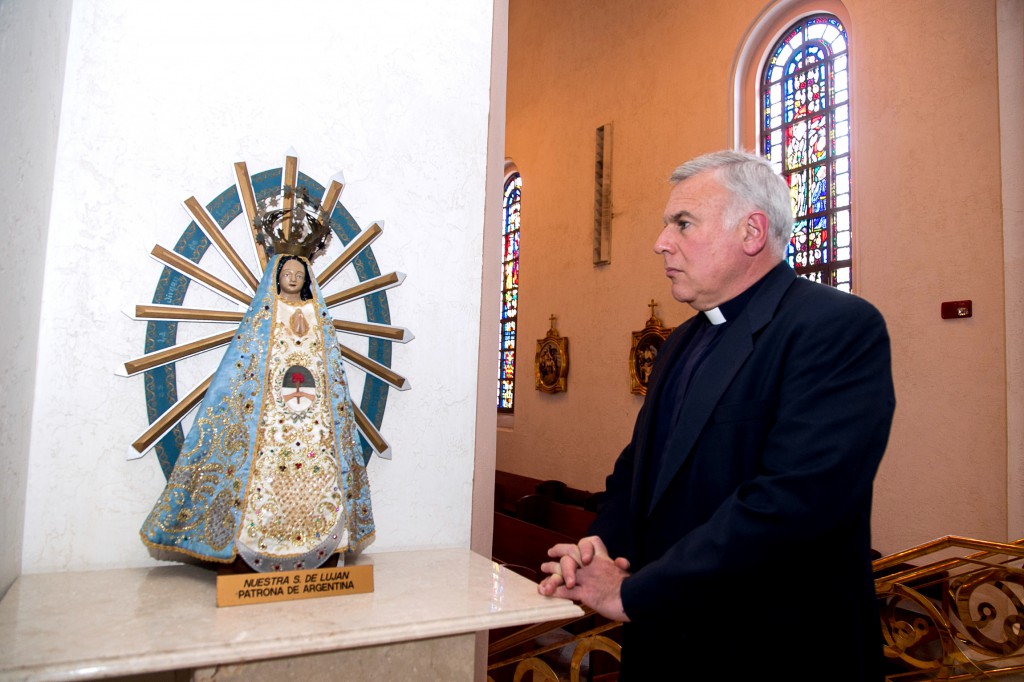
By Tom Tracy
On the evening of July 4, 1976, Rodolfo Capalozza, then a seminarian in Argentina for the Pallottine religious community in Buenos Aires, made a fateful decision to catch a movie and then visit his parents.
In the morning, Capalozza would learn that two other seminarians and three priests from the community were repeatedly shot after midnight at the church rectory of San Patricio in the Argentine capital’s Belgrano district.
It was assumed and is still asserted by survivors and many others in Argentina that elements of the military-backed dictatorship of the 1970s orchestrated the killings as reprisal after a popular revolutionary group fatally bombed a local police station during Argentina’s “dirty war.”
Tens of thousands were abducted, died or went missing during the decade-long struggle in Argentina.
Then-Father Jorge Mario Bergoglio, the future pope and Jesuit superior at the time, was spiritual adviser to one of the Pallottine priests, Father Alfredo Kelly, and later as Buenos Aires’ archbishop, he celebrated a 2001 Mass commemorating the deceased and their commitment to Gospel values.
The other victims included Fathers Alfredo Leaden and Pedro Duffau and seminarians Salvador Barbeito and Emilio Barletti. Officially, the crime was never solved and an Argentine judge at the time closed the matter judicially while several books and documentary films have explored the events.
The priests at San Patricio, whose community organizing on behalf of the poor and social justice-oriented preaching were well known in Buenos Aires, were targeted for being “lefties” and “communists,” even though it was understood they played no part in the police station bombing or in aiding or supporting armed the guerrillas known as the “Montoneros,” according to Father Capalozza.
“A week before the (massacre), we had a community meeting where we commented about the current affairs in the country: the kidnappings, disappearances and torture, and the question we asked ourselves was whether we should continue to proclaim the Gospel of life while denouncing everything that went against life in those dangerous times we were living in,” said the priest, now pastor of St. Elizabeth of Hungary Parish in Buenos Aires and secretary of the Argentine bishops’ Commission on Consecrated Life.
“The answer we gave was that we had to be faithful to Jesus Christ and the Gospel before the powerful of the world, so I am convinced that they died because of their fidelity to Christ.”
Father Capalozza was in Florida March 17 to lead a panel discussion on the San Patricio events for the community at St. Patrick Parish in Miami Beach.
On hand were Miami Archbishop Thomas G. Wenski and some 100 others, including a vice consul for Argentina in Miami. They began by watching the film “4 de Julio — La masacre de San Patricio.”
Because of their idealism, many Argentine youngsters in those years were easily “coopted” by guerrilla movements “but violence is not justifiable and even less if you consider that the guerrilla activity continued during the democratic government to follow,” Father Capalozza said.
“Many of the people who participated in the Montonero groups were from the Catholic action groups so some people identified the social commitment of the church with the Montoneros, but that is not true,” he said.
Catholics who wanted to live the Second Vatican Council and documents of the Latin American episcopate never accepted the Montoneros within their ranks, the priest said. “To the contrary the guerilla groups were never popular in Argentina.”
In relation to the Pallottine case and in general, the priest noted that the vast majority of Argentines ultimately condemned the military coup even though at the time a large part of the civilian population initially supported the coup.
Most of the Argentine people “did not desire the atrocities that were committed later on” and “wishes for justice and reconciliation to be done,” Father Capalozza said.
Father Capalozza has said he feels compelled to tell the world about the San Patricio events because to “fail to seek the truth is to betray the Gospels” and also because of the important impact those martyred had on the local community at that time.
The local church in Argentina has been supportive of the sainthood cause for the five.
“There is a commission of laypeople that is still working, gathering testimonies and proofs for all five,” Father Capalozza said. “The general chapter of the Pallottines on two occasions publicly stated that they died of the service of truth and justice and in two occasions they have formally asked that the process of beatification and canonization be expedited.”
In his homily during a 2001 Mass of commemoration, the future Pope Francis said that just as Christ was persecuted, so his disciples are persecuted, and just as Christ was labeled, so are his disciples.
“He said, ‘I am standing on martyr’s ground,’ and he spoke about his acquaintance with Alfredo Kelley, the pastor,” Father Capalozza said, adding that his work as head of religious life in Argentina has given him a close working relationship with Pope Francis.
He added that the church has a new pope with a deep identity as a pastor and a very capable intellect.
Blessed John Paul II’s papacy “was very much marked by his experience of Eastern Europe, of the war and Poland, while the papacy of Benedict XVI was marked by his experience as a theologian and scholar,” Father Capalozza said.
“And Pope Francis’ experiences in Buenos Aires likewise shaped his life,” he said, “and now he is the bishop of Rome, the mother of all the churches.” – CNS